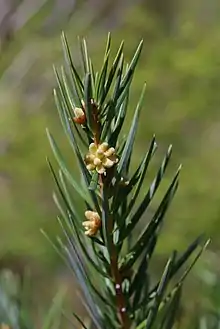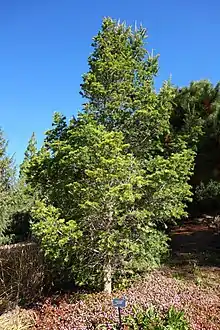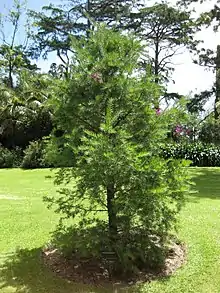Keteleeria
Keteleeria is a genus of three species of coniferous trees in the family Pinaceae first described as a genus in 1866.[1][2]
| Keteleeria | |
|---|---|
 | |
| Keteleeria evelyniana leaves | |
| Scientific classification | |
| Kingdom: | Plantae |
| Clade: | Tracheophytes |
| Division: | Pinophyta |
| Class: | Pinopsida |
| Order: | Pinales |
| Family: | Pinaceae |
| Subfamily: | Abietoideae |
| Genus: | Keteleeria Carrière |
The genus name Keteleeria honours J.B. Keteleer (1813–1903), a French nurseryman. The group is related to the genera Nothotsuga and Pseudolarix. It is distinguished from Nothotsuga by the much larger cones, and from Pseudolarix by the evergreen leaves and the cones not disintegrating readily at maturity. All three genera share the unusual feature of male cones produced in umbels of several together from a single bud, and also in their ability, very rare in the Pinaceae, of being able to coppice.
The genus is found in southern China (from Shaanxi south to Guangdong and Yunnan), Hainan, Taiwan, northern Laos, and Vietnam.[3]
They are evergreen trees reaching 35 m (115 ft) tall. The leaves are flat, needle-like, 1.5–7 cm (9⁄16–2 3⁄4 in) long and 2–4 cm (13⁄16–1 9⁄16 in) broad. The cones are erect, 6–22 cm (2 3⁄8–8 11⁄16 in) long, and mature in about 6–8 months after pollination; cone size and scale shape is very variable within all three species.
The variability of the cones has led in the past to the description of several additional species (up to 16 'species' have been named), but most authorities now only accept three species. Flora of China, however, recognized five.[4]
The World Checklist maintained by Kew Botanical Garden accepts the following:[3]
Species[3]
| Image | Name | Common name | Distribution |
|---|---|---|---|
 | Keteleeria davidiana (C.E.Bertrand) Beissn. | central and southern China, Taiwan | |
 | Keteleeria evelyniana Mast. | Evelyn keteleeria | Sichuan, Yunnan, N Laos, Vietnam |
 | Keteleeria fortunei (A.Murray) Carrière | southern China | |
- formerly included[3]
moved to Abies
- Keteleeria fabri =Abies fabri — Sichuan
Fossil record
Fossil pollen of Keteleeria caucasica have been recovered from strata of the Late Miocene in Georgia in the Caucasus region.[5] Keteleeria sp. fossils are also known from the early Pleistocene of southern Portugal.[6]
References
- Carrière, Élie Abel. 1866. Revue Horticole 37: 449
- Tropicos, Keteleeria Carrière
- Kew World Checklist of Selected Plant Families
- "Keteleeria Carrière, Rev. Hort. 37: 449. 1866". Flora of China. 4: 42.
- The History of the Flora and Vegetation of Georgia by Irina Shatilova, Nino Mchedlishvili, Luara Rukhadze, Eliso Kvavadze, Georgian National Museum Institute of Paleobiology, Tbilisi 2011, ISBN 978-9941-9105-3-1
- Fernando Reboredo, Forest Context and Policies in Portugal: Present and Future Challenges, Springer, 28 August 2014 - ISBN 978-3-319-08455-8
External links
| Wikimedia Commons has media related to Keteleeria. |